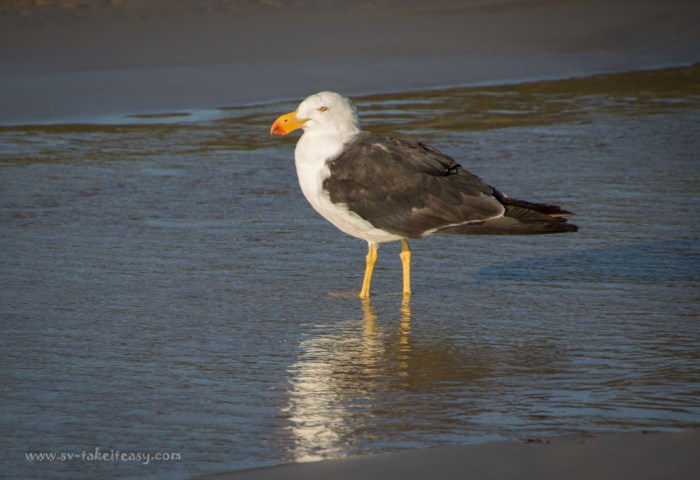The Pacific Gull (Larus pacificus) is a striking seabird which often comes to visit us when we are anchored, waiting for tasty morsels we might throw at it. This gives us a great opportunity for close up photos without too much effort! So for our #19 Bird Photography Challenge, we bring you the largest of all Australian gulls, showing off with a bit of red lippy on the beak for the fashion shots!
What does it look like?
A very large gull, endemic to Southern Australian coast, it measures 58 to 66cms long, with a wingspan of 155 to 165cms. This is quite a handsome bird with white eyes, a snow white head and body, a black mantel, black upper wings and wingtips, with a narrow white inner trailing edge. The underwings are white as is the tail except for a broad black band near the end. The legs are yellow to pale orange.What makes the Pacific Gull particularly striking is its massive and powerful yellow bill, tipped with scarlet. We have a nick name for this gull on Take It Easy: “the lipstick gull”, because it just looks like it has applied a liberal amount of bright red lipstick at the end of its beak!
Immature pacific gulls are mottled dark brown and the bill is pink with a black tip. The juveniles obtain their adult plumage gradually over 4 years.
How does it behave?
The Pacific Gull prefers beaches and estuaries that are protected from ocean swells. It forages between the high water mark and shallow water on sandy beaches, feeding on molluscs, fish, and other marine animals. When rummaging for molluscs like limpets or mussels, it can often be seen flying to some height over rocks with a shell in its beak and then dropping the shell to smash it open. It is an opportunistic feeder. We often see one or two hanging about at the back of our anchored boat, obviously waiting for titbits.Usually seen alone or in pairs, its nest is a shallow cup made of sticks, grasses or seaweed on the ground. Both sexes build the nest. The female does most of the incubation while the male forages for food and stands guard near the nest.
Did you know?
A carnivore, the Pacific Gull is quite a predator, capable of hunting a number of bird species including shearwaters and diving petrels! It can scavenge offal from fishermen, and steal fish from other birds like gannets.
Where is it found?
Despite its name the Pacific Gull is rarely seen on the Pacific coastline, and is far more common on the beaches bordering the Southern and Indian oceans. It breeds in colonies on islands from the Furneaux Group in Eastern Bass Strait to Shark Bay in the West.
The photos in this post were taken at Oberon Bay, Wilson’s Promontory, with a Canon 7D mark II, and a Tamron 18 to 270 lens. Click on any image in the gallery to display in full screen.















Gull Aloft was my pick – wish I was flying again!
Yes, nice blue sky and off it goes! Don’t you still have your wing? My favourite is the one that’s lifting off in a blur 🙂
The take offs are great Chris, for a large bird it really gets going with a flap of wings. And dangling legs. Always love the lippy.
Hi Sue – yes the lippy makes me smile! And I like that they are brave and come close to the boat – makes it easier to get good shots.
that first is a great capture!! lovely shots and information Chris!